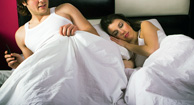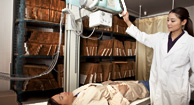Identifying and
Treating
Nocturnal Seizures

Epilepsy and Seizures During Sleep
For some people, sleep is disturbed not by dreams but by seizures. You can have a seizure while you sleep with any type of epilepsy. But with certain types of epilepsy, seizures occur only during sleep.
Learn about the types of epilepsy, seizures during sleep, and nocturnal seizures in infants and children.
Part 2 of 6: Epilepsy
What Is Epilepsy?
The cells in your brain communicate via electrical signals to other areas of your brain, muscles, and nerves. Sometimes, though, the signals go haywire, sending too many or too few signals, and you have a seizure. If you have two or more seizures at least 24 hours apart, and they weren’t caused by a medical condition, you may have epilepsy.
Epilepsy is not a single disorder. There are many different kinds of epilepsy, and the condition is common. About 2.3 million Americans have epilepsy. You can get epilepsy at any time in life. However, new cases of epilepsy are most likely to be diagnosed in infants and children under age 10 and people over age 55.
As with epilepsy, there are many different kinds of seizures. They fall roughly into two categories: generalized seizures and partial seizures.
Generalized Seizures
A generalized seizure happens when abnormal electrical activity occurs in all areas of the cerebral cortex — the top layer of the brain associated with movement, thought, reasoning, and memory. Included in this category are:
Tonic-clonic (grand mal) seizures: These seizures include a stiffening of the body, jerking motions, and usually, loss of consciousness.
Absence (petit mal) seizures: Absence seizures are characterized by brief periods of staring and may include blinking the eyes or small movements in the hands and arms.
Partial Seizures
Partial seizures, also called focal or localized seizures, occur in particular part of the brain. The person experiencing them remains conscious but may not know the seizure is happening. Partial seizures can affect behavior, consciousness, and responsiveness. They also can include involuntary movements.
Part 3 of 6: Sleep Seizures
Seizures That Occur While Sleeping
According to an article in Journal of Neurology, Neurosurgery & Psychiatry, if more than 90 percent of your seizures occur while you slumber, you are said to have sleep seizures. The article also notes that an estimated 7.5 percent to 45 percent of people who have epilepsy have some form of sleep seizures.
It’s believed that sleep seizures are triggered by changes in the electrical activity in your brain during the stages of sleeping and awakening. Most nocturnal seizures occur in stage 1 and stage 2, which are the stages of lighter sleep. Nocturnal seizures can also occur upon waking. Most often, nocturnal seizures are partial seizures.
Nocturnal seizures are associated with certain types of epilepsy, including:
- juvenile myoclonic
- awakening grand mal
- benign rolandic (also called benign focal epilepsy of childhood)
- electrical status epilepticus of sleep
- Landau-Kleffner syndrome (LKS)
- frontal onset seizures
Nocturnal seizures disrupt sleep, which affects concentration and performance at work or school. Also, unfortunately, lack of sleep is one of the most common triggers for seizures. Other triggers include stress and fever.
Part 4 of 6: In Children
Nocturnal Seizures in Infants and Young Children
Seizures and epilepsy are more common in infants and children than any other age group, according to an article in Neurology. Fortunately, when a child has epilepsy, it often doesn’t continue into adulthood.
Parents of new infants sometimes confuse a condition called benign neonatal sleep myoclonus with epilepsy. Infants experiencing myoclonus have involuntary jerking that often looks like a seizure. But an electroencephalogram (EEG) doesn’t show changes in the brain that are seen in epilepsy. Plus, myoclonus is rarely serious. For example, hiccups and jerking in sleep are forms of myoclonus.
Part 5 of 6: Diagnosis
Diagnosing Nocturnal Seizures
It can be tricky to diagnose nocturnal seizures because they occur during sleep, and you may not be aware of them. Also, nocturnal seizures can be confused with parasomnia, an umbrella term for a group of sleep disorders that include sleepwalking, teeth grinding, and restless leg syndrome.
Doctors evaluate a number of factors to diagnose epilepsy and determine the type. Factors include:
- the type of seizures you have
- the age when you began having seizures
- family history of epilepsy
- other medical conditions you may have
To diagnose epilepsy, doctors may use:
- images of electrical activity in your brain recorded by an electroencephalogram (EEG)
- the structure of your brain as shown in a computed tomography (CT) scan or magnetic resonance imaging (MRI)
- a record or diary of your seizure activity
If you suspect that your infant or child is having nighttime seizures, consult with your doctor. You can monitor the child by:
- using a baby monitor
- watching for signs in the morning, such as unusual sleepiness, headache, and signs of drooling, vomiting or bed-wetting
- using a seizure monitor, which has features like a motion, noise, and moisture sensors
Part 6 of 6: Treatments
Treatments for Epilepsy
If you have nocturnal seizures, you most likely experience partial-onset seizures. According to researchers at the Indiana University School of Medicine, these seizures are normally well controlled by medication. Indeed, medication is the first-line treatment for epilepsy. Your doctor will help find the medication that works best for you or your child.
